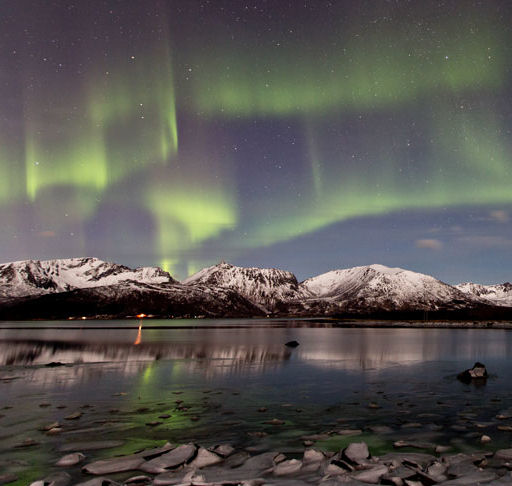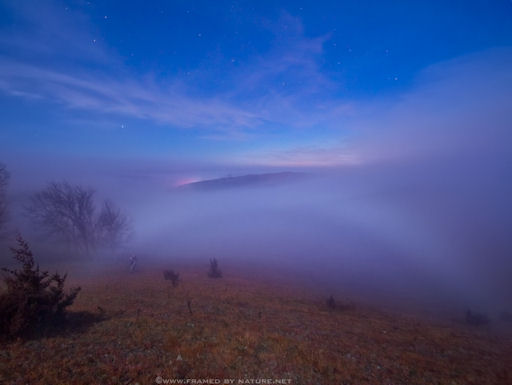ANOTHER QUIET DAY: With all of the sunspots on the Earthside of the sun in decay, solar activiy is low. NOAA forecasters estimate a slight 1% chance of strong solar flares during the next 24 hours. Solar flare alerts: text, voice.
SOLAR WIND: A medium-speed (~450 km/s) solar wind stream is blowing past Earth. The action of this weak stream is not enough to trigger full-fledged geomagnetic storms, but it is enough to ignite auroras around the Arctic Circle. Frank Olsen of Sortland, Norway, took this picture during the early hours of Dec. 4th:
The odds of a gomagnetic storm today remain low--only 5% to 15% according to NOAA--but more Arctic lights are in the offing as the solar wind contiinues to blow. Check the aurora gallery for updates.
GHOSTLY WHITE RAINBOW: Dec. 1st was a foggy night in Little Sioux, Iowa. Nevertheless, Evan Ludes decided to go outside to photograph the nearly-full Moon (and "to play in the fog," he says). The Moon was high and bright, as expected, and when he finished snapping the lunar disk, he turned around to find this ghostly white rainbow behind his back:
"It was a lunar fogbow," explains Ludes.
Fogbows are sometimes called "white rainbows," and that's about right. Both rainbows and fogbows are caused by light reflected from water droplets. When the droplets are large (rain), they act like prisms, spreading the colors wide for easy visibility. When the droplets are small (fog), the prism-action is reduced, and colors are smeared together into a ghostly-white arc.
"I also saw a fogbow created by our headlights," he adds. "It was incredibly bright visually, and this was my first time ever seeing one!"

![]()
Solar wind
speed: 408.5 km/sec
density: 2.4 protons/cm3
explanation | more data
Updated: Today at 2227 UT
![]()
X-ray Solar Flares
6-hr max: B2 2046 UT Dec04
24-hr: B7 0212 UT Dec04
explanation | more data
Updated: Today at: 2200 UT
![]()
![]()
![]()
Daily Sun: 04 Dec 12
![]()
![]()
None of the spots on the Earthside of the sun pose a threat for strong solar flares. Credit: SDO/HMI
![]()
![]()
![]()
Sunspot number: 44
What is the sunspot number?
Updated 04 Dec 2012
Spotless Days
Current Stretch: 0 days
2012 total: 0 days (0%)
2011 total: 2 days (<1%)
2010 total: 51 days (14%)
2009 total: 260 days (71%)
Since 2004: 821 days
Typical Solar Min: 486 days
Update 04 Dec 2012
The Radio Sun
10.7 cm flux: 97 sfu
explanation | more data
Updated 04 Dec 2012
![]()
![]()
![]()
Current Auroral Oval:
![]()
Switch to: Europe, USA, New Zealand, Antarctica
Credit: NOAA/POES
![]()
![]()
![]()
Planetary K-index
Now: Kp= 1 quiet
24-hr max: Kp= 2 quiet
explanation | more data
![]()
Interplanetary Mag. Field
Btotal: 2.4 nT
Bz: 1.3 nT north
explanation | more data
Updated: Today at 2227 UT
![]()
![]()
![]()
Coronal Holes: 04 Dec 12
![]()
![]()
There are no large coronal holes on the Earthside of the sun. Credit: SDO/AIA.






